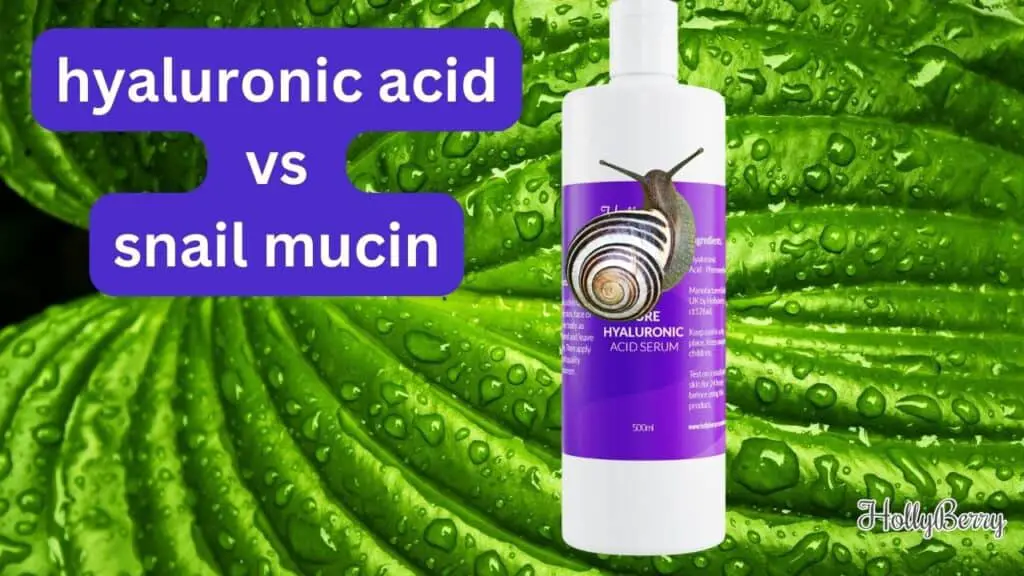
Hyaluronic acid and snail mucin are two popular ingredients found in many skincare products today. Both are known for their ability to hydrate and moisturize the skin, but they have some key differences in terms of composition and benefits.
Hyaluronic acid is a polysaccharide made up of repeating units of glucuronic acid and N-acetylglucosamine. It is known for its ability to hold up to 1000 times its weight in water, making it an extremely effective moisturizer. It also has anti-ageing benefits, helping to plump and smooth out wrinkles and fine lines.
Snail mucin, on the other hand, is composed primarily of glycoprotein and glycosaminoglycans. It’s known for its ability to repair and regenerate the skin, helping to reduce the appearance of scars and other skin imperfections. It also has anti-inflammatory properties, making it helpful for those with acne-prone skin.
Both hyaluronic acid and snail mucin can be found in a variety of skincare products, including serums, creams, and masks. They can also be used together for maximum benefits. However, it’s important to note that the effectiveness of these ingredients can vary depending on the specific product and concentration used.
Always be sure to check the label and do your own research to ensure that you’re using the best product for your skin type and concerns.
Does one have more anti-aging benefits than the other?
When it comes to anti-aging benefits, hyaluronic acid and snail mucin both have their own strengths.
Snail mucin is known for its ability to repair and regenerate the skin. It’s great for reducing the appearance of scars and other imperfections, leaving the skin with a more even and smooth texture.
Both ingredients can be beneficial for anti-ageing, but hyaluronic acid is generally considered to be more effective when it comes to targeting fine lines and wrinkles specifically. Order our Hyaluronic Acid here at our store.
Are there any potential side effects associated with using products containing either hyaluronic acid or snail mucin?
When it comes to potential side effects, both hyaluronic acid and snail mucin are generally considered to be safe for most people. However, as with any skincare product, it’s always a good idea to patch test before using it all over your face and to check the ingredients list for any potential allergens.
Hyaluronic acid, in general, is considered safe for most skin types, but in some rare cases, it may cause mild skin irritation or redness. However, these side effects are usually temporary and will disappear after a short period of time.
Snail mucin, like hyaluronic acid, is considered safe for most skin types, but again do a patch test if you have sensitive skin or have known allergies to any of the ingredients in the product. It’s also important to note that some people may be allergic to snail mucin, so it’s important to be cautious if you’re trying it for the first time.
Overall, both hyaluronic acid and snail mucin are great ingredients that offer many benefits for the skin. Just be mindful of any potential allergies or sensitivities you may have, and always patch test before using any new product.
Is one more effective for specific skin concerns such as wrinkles or pigmentation?
Hyaluronic acid and snail mucin are both great ingredients that offer many benefits for the skin. But when it comes to specific skin concerns, they each have their own strengths.
Hyaluronic acid is known for its ability to hydrate and moisturize the skin, making it a great choice for those with dry or dehydrated skin. It’s also great for anti-ageing concerns.
Is hyaluronic acid or snail mucin better for acne-prone skin?
So when it comes to acne-prone skin, snail mucin is known to be more beneficial. This is because it contains anti-inflammatory properties, which can help to reduce redness and inflammation caused by acne.
On the other hand, hyaluronic acid is known for its ability to hydrate and moisturize the skin, which can be helpful for those with dry or dehydrated skin.
Both ingredients have their own unique benefits, and using a combination of the two can be even more effective.
So can both hyaluronic acid and snail mucin be used together?
Absolutely! In fact, using both hyaluronic acid and snail mucin together can be a great way to maximize the benefits for your skin. Since they have different benefits, they complement each other nicely. Hyaluronic acid is great for hydration and moisturizing, while snail mucin is known for its ability to repair and regenerate the skin.
So, using them together can give you the best of both worlds. Just be sure to check the label of the product and do your own research to ensure that you’re using the best product for your skin type and concerns.


